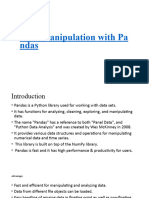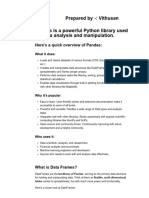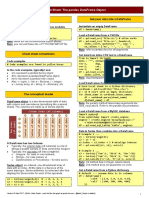Learn Data Analysis With Pandas - Introduction
Uploaded by
Cleber_Rocha_SantosLearn Data Analysis With Pandas - Introduction
Uploaded by
Cleber_Rocha_SantosCheatsheets / Learn Data Analysis with Pandas
Introduction to Pandas
Pandas DataFrame creation
The fundamental Pandas object is called a DataFrame.
It is a 2-dimensional size-mutable, potentially # Ways of creating a Pandas DataFrame
heterogeneous, tabular data structure. # Passing in a dictionary:
A DataFrame can be created multiple ways. It can be data = {'name':['Anthony', 'Maria'], 'age':
created by passing in a dictionary or a list of lists to the
[30, 28]}
pd.DataFrame() method, or by reading data from a CSV
df = pd.DataFrame(data)
le.
# Passing in a list of lists:
data = [['Tom', 20], ['Jack', 30], ['Meera',
25]]
df = pd.DataFrame(data, columns = ['Name',
'Age'])
# Reading data from a csv file:
df = pd.read_csv('students.csv')
Pandas
Pandas is an open source library that is used to analyze
data in Python. It takes in data, like a CSV or SQL import pandas as pd
database, and creates an object with rows and columns
called a data frame. Pandas is typically imported with
the alias pd .
Selecting Pandas DataFrame rows using logical operators
In pandas, speci c rows can be selected if they satisfy
certain conditions using Python’s logical operators. The # Selecting rows where age is over 20
result is a DataFrame that is a subset of the original df[df.age > 20]
DataFrame.
Multiple logical conditions can be combined with OR # Selecting rows where name is not John
(using | ) and AND (using & ), and each condition must
df[df.name != "John"]
be enclosed in parentheses.
# Selecting rows where age is less than 10
# OR greater than 70
df[(df.age < 10) | (df.age > 70)]
Pandas apply() function
The Pandas apply() function can be used to apply a
function on every value in a column or row of a # This function doubles the input value
DataFrame, and transform that column or row to the def double(x):
resulting values. return 2*x
By default, it will apply a function to all values of a
column. To perform it on a row instead, you can specify
# Apply this function to double every value
the argument axis=1 in the apply() function call.
in a specified column
df.column1 = df.column1.apply(double)
# Lambda functions can also be supplied to
`apply()`
df.column2 = df.column2.apply(lambda x : 3*x)
# Applying to a row requires it to be called
on the entire DataFrame
df['newColumn'] = df.apply(lambda row:
row['column1'] * 1.5 + row['column2'],
axis=1
)
Pandas DataFrames adding columns
Pandas DataFrames allow for the addition of columns
after the DataFrame has already been created, by using # Specifying each value in the new column:
the format df['newColumn'] and setting it equal to the df['newColumn'] = [1, 2, 3, 4]
new column’s value.
# Setting each row in the new column to the
same value:
df['newColumn'] = 1
# Creating a new column by doing a
# calculation on an existing column:
df['newColumn'] = df['oldColumn'] * 5
You might also like
- b07 - Process Simulate Virtual Commissioning PDFNo ratings yetb07 - Process Simulate Virtual Commissioning PDF25 pages
- Data Analysis With Pandas - Introduction To Pandas Cheatsheet - Codecademy PDFNo ratings yetData Analysis With Pandas - Introduction To Pandas Cheatsheet - Codecademy PDF3 pages
- Data Analysis With Pandas - Introduction To Pandas Cheatsheet - Codecademy PDFNo ratings yetData Analysis With Pandas - Introduction To Pandas Cheatsheet - Codecademy PDF3 pages
- Data Analysis With Pandas - Introduction To Pandas Cheatsheet - Codecademy PDF100% (1)Data Analysis With Pandas - Introduction To Pandas Cheatsheet - Codecademy PDF3 pages
- Data Analysis With Pandas - Introduction To Pandas Cheatsheet - CodecademyNo ratings yetData Analysis With Pandas - Introduction To Pandas Cheatsheet - Codecademy3 pages
- Data Manipulation With Pandas - Introduction To Pandas Reference Guide - CodecademyNo ratings yetData Manipulation With Pandas - Introduction To Pandas Reference Guide - Codecademy3 pages
- Chapter Notes - Data Handling Using Pandas DataFrameNo ratings yetChapter Notes - Data Handling Using Pandas DataFrame16 pages
- Lab3 - Python - Pandas DataFrame - GeeksforGeeksNo ratings yetLab3 - Python - Pandas DataFrame - GeeksforGeeks20 pages
- Chapter 2 Data Handling using pandas - I(DATA FRAME)No ratings yetChapter 2 Data Handling using pandas - I(DATA FRAME)15 pages
- Cheat Sheet: The Pandas Dataframe Object I: Preliminaries Get Your Data Into A DataframeNo ratings yetCheat Sheet: The Pandas Dataframe Object I: Preliminaries Get Your Data Into A Dataframe12 pages
- Class Notes: Class: XII Date: 7-Apr-2020 Subject: Informatics Practices Topic: 2. Python PandasNo ratings yetClass Notes: Class: XII Date: 7-Apr-2020 Subject: Informatics Practices Topic: 2. Python Pandas4 pages
- Python For Data Science Cheat Sheet 2.0No ratings yetPython For Data Science Cheat Sheet 2.011 pages
- Cheat Sheet: The Pandas Dataframe Object: Preliminaries Get Your Data Into A Dataframe100% (1)Cheat Sheet: The Pandas Dataframe Object: Preliminaries Get Your Data Into A Dataframe10 pages
- Cheat Sheet: The Pandas Dataframe Object: Preliminaries Get Your Data Into A Dataframe100% (1)Cheat Sheet: The Pandas Dataframe Object: Preliminaries Get Your Data Into A Dataframe12 pages
- Java Programming Tutorial With Screen Shots & Many Code ExampleFrom EverandJava Programming Tutorial With Screen Shots & Many Code ExampleNo ratings yet
- Learn Python 3 - Python - Code ChallengesNo ratings yetLearn Python 3 - Python - Code Challenges7 pages
- Learn Data Analysis With Pandas - Aggregates in PandasNo ratings yetLearn Data Analysis With Pandas - Aggregates in Pandas2 pages
- PLM Software: Working in Both Traditional and Synchronous Mode While Using Solid EdgeNo ratings yetPLM Software: Working in Both Traditional and Synchronous Mode While Using Solid Edge16 pages
- A Beginner's Guide To Everything DevOps - Opensource - Com1No ratings yetA Beginner's Guide To Everything DevOps - Opensource - Com11 page
- Best-Practices For Large Eddy Simulations (LES) in FLUENTNo ratings yetBest-Practices For Large Eddy Simulations (LES) in FLUENT2 pages
- Getting Started With R: An Introduction For Biologists. ISBN 9780198787846, 978-0198787846100% (16)Getting Started With R: An Introduction For Biologists. ISBN 9780198787846, 978-019878784623 pages
- Introduction To Computer-Aided Design of VLSI Circuits: Unit 1 1No ratings yetIntroduction To Computer-Aided Design of VLSI Circuits: Unit 1 164 pages
- J2Ee/Jee (Java 2 Enterprise Edition) TechnologyNo ratings yetJ2Ee/Jee (Java 2 Enterprise Edition) Technology36 pages
- The Importance of Educational Technology in TeachingNo ratings yetThe Importance of Educational Technology in Teaching5 pages
- Accounting Information Systems 10th Edition Gelinas Test Bank 1100% (64)Accounting Information Systems 10th Edition Gelinas Test Bank 129 pages



































































































